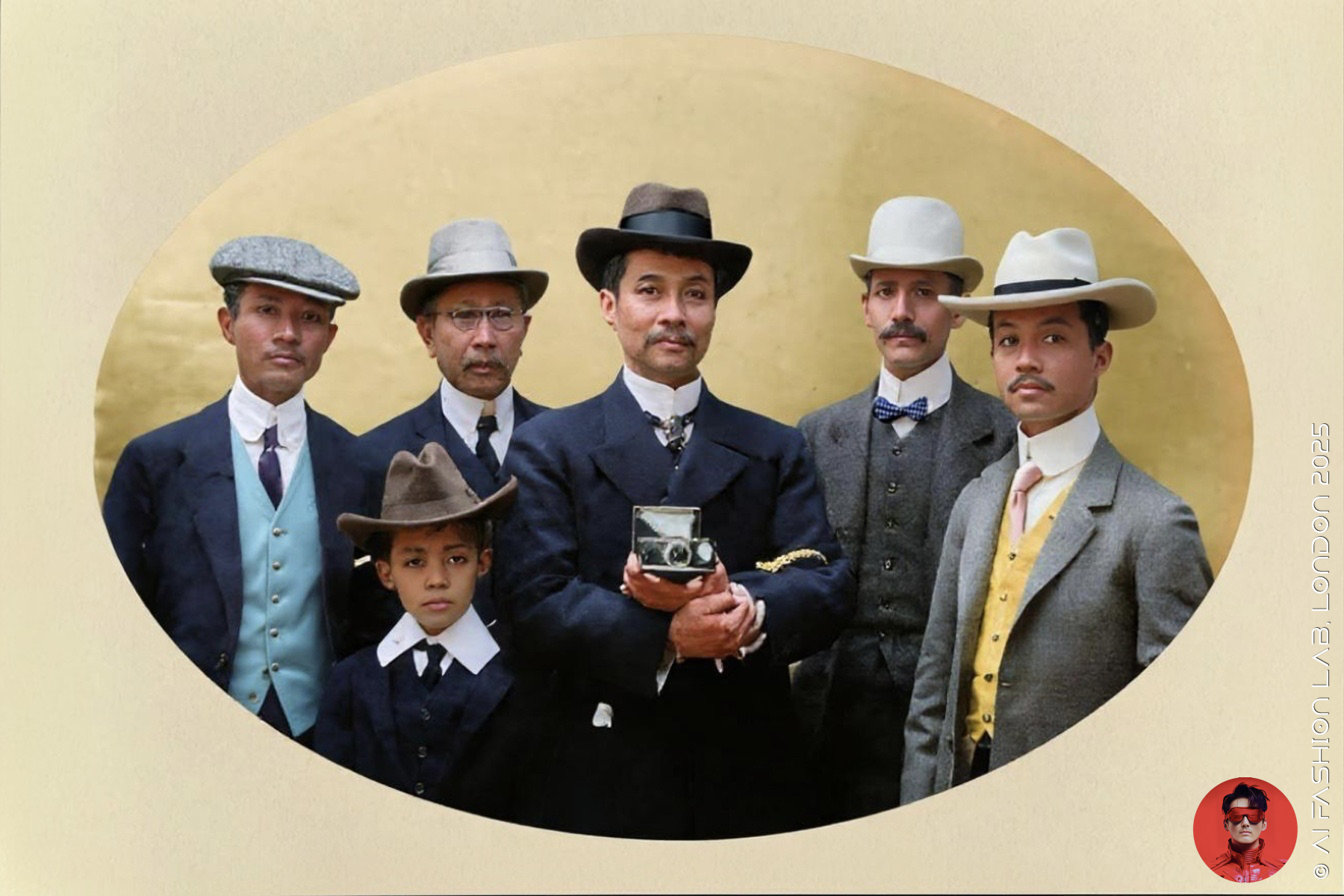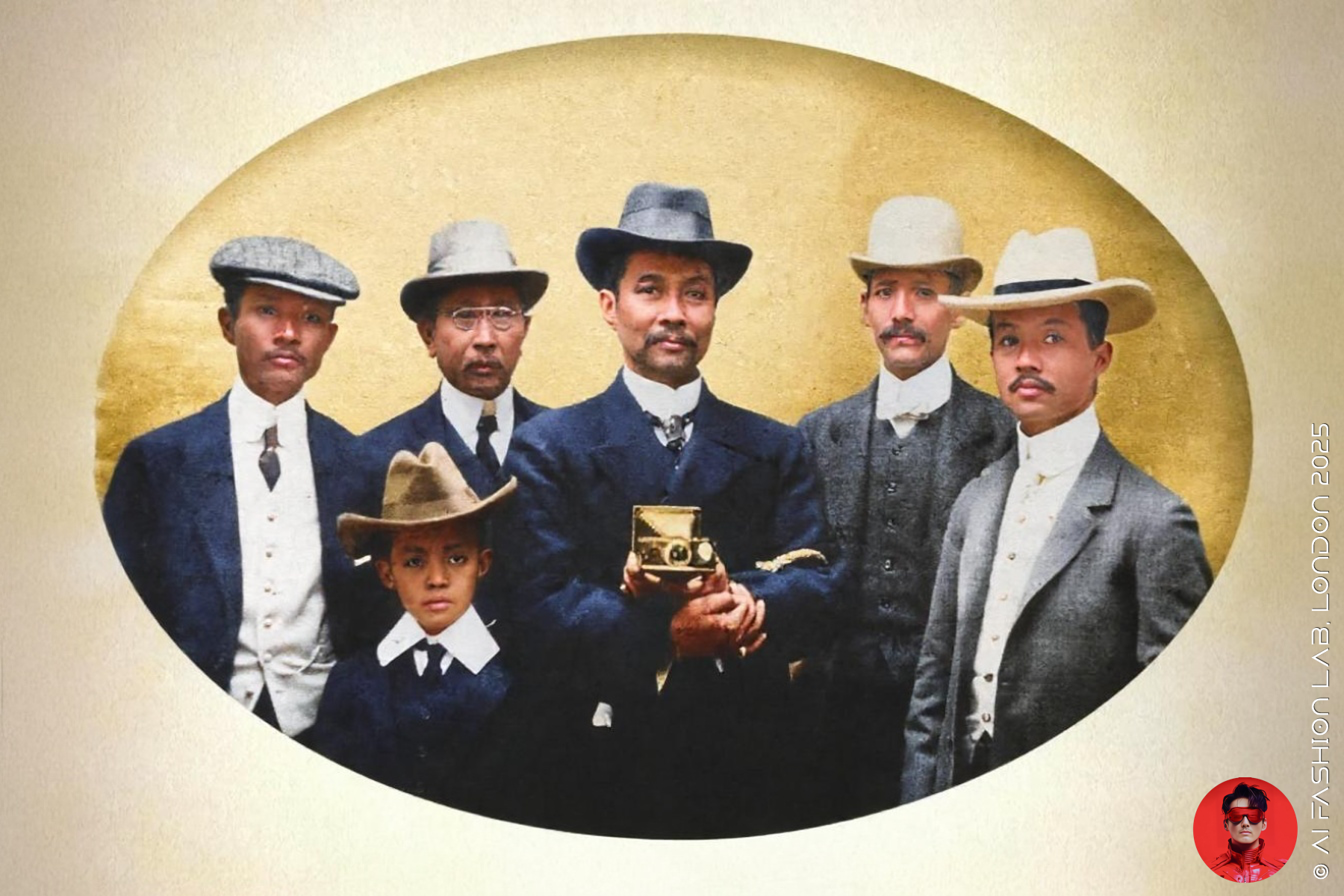หนึ่งในเซลฟี่แรกของสยาม: พระบรมฉายาลักษณ์แบบหมู่และบริบทแฟชั่นสากลในต้นคริสต์ศตวรรษที่ 20 (ตอนที่ 2)
หนึ่งในเซลฟี่แรกของสยาม: พระบรมฉายาลักษณ์แบบหมู่และบริบทแฟชั่นสากลในต้นคริสต์ศตวรรษที่ 20 (ตอนที่ 2)
🕰️ ตอนต่อจากเมื่อวานครับ
พระบรมฉายาลักษณ์ของ พระบาทสมเด็จพระจุลจอมเกล้าเจ้าอยู่หัว บนหน้าปกนิตยสารฝรั่งเศสรายเดือน Je sais tout ฉบับวันที่ 15 สิงหาคม พ.ศ. 2450 ขณะทรงถือกล้องถ่ายภาพแบบพับได้ ซึ่งอาจนับได้ว่าเป็นหนึ่งใน “เซลฟี่แรกของสยาม” ก็ว่าได้!
แต่แท้จริงแล้ว ภาพนี้มิใช่ภาพเดี่ยว หากแต่เป็น ภาพหมู่ ซึ่งทรงฉายร่วมกับพระบรมวงศานุวงศ์ ระหว่างการเสด็จประพาสยุโรปครั้งที่ 2 ในปี พ.ศ. 2450 (ค.ศ. 1907)
📸 ในภาพปรากฏพระบรมวงศานุวงศ์อีกหลายพระองค์ที่โดยเสด็จในการเดินทางครั้งประวัติศาสตร์นี้
🙏ขอบพระคุณคุณวิญญูชนก แก้วนอก ที่ช่วยอ่านภาพครับ
แถวหน้าจากซ้ายไปขวา
● พระเจ้าบรมวงศ์เธอ กรมหลวงราชบุรีดิเรกฤทธิ์ (พระองค์เจ้ารพีพัฒนศักดิ์)
● พระเจ้าบรมวงศ์เธอ พระองค์เจ้าอุรุพงษ์รัชสมโภช
● พระบาทสมเด็จพระจุลจอมเกล้าเจ้าอยู่หัว
● สมเด็จพระเจ้าบรมวงศ์เธอ เจ้าฟ้าบริพัตรสุขุมพันธุ์ กรมพระนครสวรรค์วรพินิต
ทรงฉายช่วงที่พระบาทสมเด็จพระจุลจอมเกล้าเจ้าอยู่หัว รัชกาลที่ ๕ ขณะประทับที่วิลลาโนเบล เมืองซันเรโม ประเทศอิตาลี เมื่อคราวเสด็จประพาสยุโรปครั้งที่ ๒ เพื่อรักษาพระอาการประชวร อิตาลีเป็นประเทศที่พระองค์ประทับนานถึง ๑๖ วันซึ่งนานที่สุดในการเสด็จประพาสครั้งที่ ๒
เมื่อวานนี้ผมได้โพสต์ ภาพสีที่ลงใหม่ของหน้าปก Je sais tout ฉบับดังกล่าว ซึ่งปรากฏพระบรมฉายาลักษณ์ของรัชกาลที่ 5 ขณะทรงถือกล้องถ่ายภาพแบบพับได้ ภาพนี้ไม่เพียงเป็นหลักฐานทางเทคโนโลยีภาพถ่ายในยุคต้นคริสต์ศตวรรษที่ 20 เท่านั้น หากยังสะท้อนถึงบทบาทของพระองค์ในฐานะผู้นำผู้ทรงเข้าใจพลังของ “ภาพถ่าย” ในการจารึกพระราชกรณียกิจ และสื่อสารภาพลักษณ์แห่งความศิวิไลซ์ของสยามในเวทีนานาชาติ
🧥 ศึกษาการแต่งกายและแฟชั่นการทูตจากพระบรมฉายาลักษณ์ที่ผ่านการแต่งแต้มสีด้วย AI (ราว พ.ศ. 2450)
พระบรมฉายาลักษณ์แบบหมู่นี้บันทึกช่วงเวลาอันทรงความหมายในประวัติศาสตร์สยาม ขณะพระบาทสมเด็จพระจุลจอมเกล้าเจ้าอยู่หัวเสด็จประพาสยุโรปครั้งที่ 2 ในปี พ.ศ. 2450 ทรงถือกล้องถ่ายภาพแบบพับได้ด้วยพระองค์เอง
แม้ภาพนี้จะอาจจะเป็นหนึ่งใน “เซลฟี่แรกของสยาม” แต่แท้จริงแล้วเป็น ภาพหมู่ร่วมกับพระบรมวงศานุวงศ์ ซึ่งทุกพระองค์ทรงฉลองพระองค์ด้วยเสื้อผ้าแบบตะวันตกอย่างงดงาม
เวอร์ชันภาพที่ปรากฏนี้ได้รับการ ลงสีด้วย AI เพื่อจุดประสงค์เชิงศิลปะ สีสันที่เห็นอาจไม่ตรงกับต้นฉบับทางประวัติศาสตร์ แต่ผมตั้งใจให้ภาพนี้ถ่ายทอด บรรยากาศแฟชั่นในช่วงต้นคริสต์ศตวรรษที่ 20 และเน้นอิทธิพลของความงามในเครื่องแต่งกายบุรุษแบบสากล ภาพนี้จึงควรเข้าใจว่าเป็น การตีความเชิงสร้างสรรค์ มิใช่การจำลองข้อเท็จจริงทางประวัติศาสตร์
👑 ฉลองพระองค์ของกษัตริย์: ความทันสมัยในนามแห่งการทูต
กลางภาพคือพระบาทสมเด็จพระจุลจอมเกล้าเจ้าอยู่หัว ทรงฉลองพระองค์ เสื้อโค้ตตัวยาวแบบฟร็อกโค้ต (frock coat)กระดุมสองแถว ตัดเย็บจากผ้าสีเข้มอย่างประณีต มีปกเสื้อคมชัดและโครงเสื้อที่ออกแบบอย่างประณีต
ด้านในทรงสวม เสื้อกั๊ก, ปกเสื้อแบบแข็ง (imperial collar) และ เนกไทผ้าไหมผูกเรียบร้อย ซึ่งล้วนเป็นลักษณะการแต่งกายของชนชั้นสูงในยุโรปช่วงปลายศตวรรษที่ 19 ถึงต้นศตวรรษที่ 20
พระองค์ยังทรงสวม หมวกฮอมเบิร์ก (Homburg hat) ที่มีรอยพับกลางและประดับริบบิ้นผ้ากรอสเกรน หมวกชนิดนี้แม้จะนิยมกับชุดกลางวัน (lounge suit) แต่ในหมู่นักการทูตและขุนนางยุคเอ็ดเวิร์เดียนก็มักจับคู่กับฟร็อกโค้ตเช่นกัน เครื่องแต่งกายทั้งหมดนี้สะท้อนถึง ความสุขุม สง่างาม และการรับรู้ภาพลักษณ์ในระดับสากล—สมดุลระหว่างธรรมเนียมเก่าแก่กับโลกสมัยใหม่
🎩 การแต่งกายของบุรุษในภาพ: แฟชั่นตะวันตกในบริบทของสยาม
บุคคลอื่นในภาพแต่งกายด้วยชุดสไตล์ตะวันตกหลากหลายแบบ ซึ่งแสดงให้เห็นถึง การปรับใช้แฟชั่นยุโรปในสยาม ชุดแต่ละชุดล้วนเล่าเรื่องราวของ แฟชั่นเชิงการทูต การเดินทาง และการแลกเปลี่ยนวัฒนธรรม ดังนี้:
* บุรุษทางซ้ายสุด พระเจ้าบรมวงศ์เธอ กรมหลวงราชบุรีดิเรกฤทธิ์ (พระองค์เจ้ารพีพัฒนศักดิ์) ทรง ชุดสูทสีเข้มแบบ lounge suit จับคู่กับ เสื้อกั๊กสีเขียวอมฟ้า เพิ่มความโดดเด่น หมวกแก๊ปแบบ newsboy และปกเสื้อมนสะท้อนลุคหนุ่มนักเรียนหรือนักเดินทางตามแบบนิยมในอังกฤษต้นศตวรรษที่ 20
* ถัดมาเป็นบุรุษใน ชุดสูทสามชิ้น (three-piece suit) สวมแว่นสายตาและหมวกสักหลาดสุภาพ เรียบง่ายแต่ภูมิฐาน ดูคล้ายขุนนางอาวุโสหรือที่ปรึกษา
* เด็กชายที่ยืนอยู่เบื้องหน้า พระเจ้าบรมวงศ์เธอ พระองค์เจ้าอุรุพงษ์รัชสมโภช ทรง เสื้อสูทเข้ารูปและปกเสื้อแข็งแบบ Eton collar อันเป็นเอกลักษณ์ของนักเรียนโรงเรียนอีตันในอังกฤษ พร้อมหมวกเฟโดราปีกกว้าง ช่วยเสริมบุคลิกให้ดูภูมิฐานเกินวัย
* บุรุษกลางภาพขวา สวม ชุดสูทสีเทา, โบว์ไท, และ หมวกโบว์เลอร์สีอ่อน รูปลักษณ์และหนวดเรียวแบบตะวันตก บ่งบอกถึงความคุ้นเคยกับมารยาทสากล
* บุรุษทางขวาสุด สมเด็จพระเจ้าบรมวงศ์เธอ เจ้าฟ้าบริพัตรสุขุมพันธุ์ กรมพระนครสวรรค์วรพินิต เพิ่มความโดดเด่นด้วย เสื้อกั๊กสีเหลืองอ่อน, เนกไทสีชมพูอ่อน, และ หมวกเฟโดราสีขาวสะอาด การใช้สีสันอย่างมั่นใจนี้สะท้อนรสนิยมแบบผู้ดีมีสไตล์ในหมู่ชนชั้นนำต้นศตวรรษที่ 20
ทุกบุคคลในภาพล้วนสะท้อนแง่มุมที่หลากหลายของ แฟชั่นบุรุษในช่วงเปลี่ยนผ่านของโลก ตั้งแต่ความสง่างามแบบนักการทูต ไปจนถึงความสดใหม่แบบคนวัยหนุ่ม สะท้อนให้เห็นถึง ความเป็นสากลของสยาม ในห้วงเวลาที่กำลังนิยามตนเองใหม่ท่ามกลางกระแสโลกาภิวัตน์
ภาพเวอร์ชันนี้ที่ผ่านการแต่งสีด้วย AI ไม่ได้มีจุดมุ่งหมายในการจำลองสีจริงทางประวัติศาสตร์ แต่เป็น การตีความแฟชั่น ความเป็นทางการ และความงามแห่งยุคสมัย ผ่านมุมมองร่วมสมัย เป็นเครื่องเตือนใจว่า แม้เวลาจะล่วงเลยมากว่าร้อยปี เครื่องแต่งกายและภาพลักษณ์ภายนอกก็ยังเป็นเครื่องมือสื่อสารที่ทรงพลังในการบอกเล่าเรื่องราวแห่ง อัตลักษณ์ ความศิวิไลซ์ และการทูต สู่สายตาชาวโลก
One of Siam’s First Selfies: A Group Royal Portrait and Global Fashion Context in the Early 20th Century (Part 2)
🕰️ A continuation from yesterday
This royal portrait of His Majesty King Chulalongkorn (Rama V) appeared on the cover of the French monthly magazine Je sais tout, dated 15 August 1907. In the image, His Majesty holds a folding camera—making it arguably one of Siam’s first “selfies.”
However, the image is not a solo portrait. It is in fact a group photograph, taken during His Majesty’s second royal visit to Europe in 1907, where he is joined by several members of the royal family.
📸 The image shows several Siamese royals who accompanied the King on this historic journey.
🙏 I would like to ask for your help:
📣 If anyone can identify the individuals in this photograph, please comment below.
References or supporting materials are most welcome!
Yesterday, I posted a colourised version of the Je sais tout cover, featuring King Chulalongkorn holding a folding camera. This image is not only a testament to photographic technology in the early 20th century, but also reflects His Majesty’s understanding of photography as a tool of historical record and a means to convey Siam’s image as a civilised and modern nation to the world.
🧥 A Study of Dress and Diplomatic Fashion in an AI-Enhanced Royal Photograph (c. 1907)
This group portrait marks a historically significant moment during King Chulalongkorn’s second journey to Europe in 1907. In it, His Majesty is seen holding a folding camera—possibly taking the photograph himself.
While the image is often described as one of Siam’s earliest selfies, it is actually a group portrait with several royals dressed in elegant Western attire.
The version of the image shown here has been colourised using AI for artistic purposes. The colours may not reflect the original historical garments, but were chosen to evoke the atmosphere of early 20th-century fashion and highlight the influence of international menswear aesthetics of the time. This image should be understood as a creative interpretation, not a factual recreation.
👑 The King’s Ensemble: Modernity as Diplomacy
At the centre of the image, King Chulalongkorn wears a double-breasted frock coat, meticulously tailored from dark fabric, with sharp lapels and a carefully constructed silhouette.
Beneath it, he wears a waistcoat, a stiff imperial collar, and a silk necktie, all of which reflect the attire of upper-class Europeans in the late 19th and early 20th centuries.
He also dons a Homburg hat, distinguished by its centre crease and grosgrain ribbon. Although often paired with lounge suits, the Homburg was also worn with frock coats by diplomats and aristocrats in the Edwardian era. His entire ensemble exudes composure, elegance, and a sense of international poise—a balance between tradition and the modern world.
🎩 The Gentlemen’s Dress: Western Fashion in a Siamese Context
The other men in the image wear various styles of Western attire, reflecting Siam’s adoption and adaptation of European fashion. Each outfit tells a story of diplomatic style, travel, and cultural exchange, as follows:
The gentleman on the far left wears a dark lounge suit paired with a turquoise waistcoat, which adds a bold touch. His newsboy cap and rounded collar evoke the style of students or young travellers in early 20th-century Britain.
Next to him stands a man in a conservative three-piece suit, wearing spectacles and a felt hat. His look is simple yet dignified—reminiscent of a senior nobleman or advisor.
A young boy in front wears a tailored jacket with a stiff Eton collar, a distinctive feature of school uniforms from Eton College in England. His wide-brimmed fedora-style hat enhances his mature and composed appearance.
The gentleman at the right of centre wears a mid-grey suit, a bow tie, and a light-coloured bowler hat. His well-groomed moustache and confident posture signal familiarity with Western manners.
The man on the far right adds flair with a pale yellow waistcoat, a light pink necktie, and a crisp white fedora. His confident use of colour reflects upper-class fashion sensibilities in the early 20th century.
Each individual in the photo reflects different facets of men’s fashion at the turn of the century—from diplomatic formality to youthful modernity—coming together as a portrait of cosmopolitan Siam during a time of self-definition amid globalisation.
This AI-enhanced version of the photograph is not intended to replicate historical colours with accuracy, but rather serves as a creative exploration of fashion, formality, and visual aesthetics of the period. It reminds us that, even over a century ago, clothing and personal appearance were powerful tools for expressing identity, civilisation, and diplomacy—projecting the image of a nation to the world.
#aifashionlab #AI #aiartist #aiart #aifashion #aifashiondesign #aifashionstyling #aifashiondesigner #fashion #fashionhistory #historyoffashion #fashionstyling #fashionphotography #digitalfashion #digitalfashiondesign #digitalcostumedesign #digitaldesign #digitalaiart #ThaiFashionHistory #ThaiFashionAI



